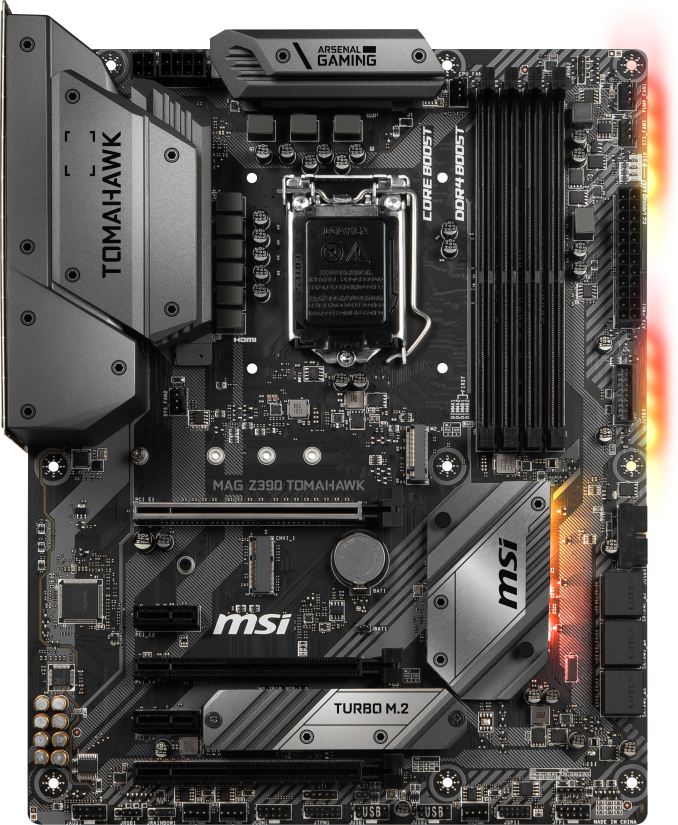Intel Z390 Motherboard Overview: 50+ Motherboards Analyzed
by Ian Cutress & Gavin Bonshor on October 8, 2018 10:53 AM EST- Posted in
- Motherboards
- Intel
- MSI
- Gigabyte
- ASRock
- EVGA
- Asus
- NZXT
- Supermicro
- Z390
MSI MAG Z390 Tomahawk
The MSI MAG or 'Arsenal' range is somewhat unchained and features the more militaristic sounding boards such as this one, the MAG Z390 Tomahawk. The Tomahawk has an overall black and silver theme throughout with a very solid looking silver grey for the heatsinks and rear panel cover. The board does utilize basic RGB LED lighting across the chipset heatsink and the underneath of the 24-pin motherboard power connector and can be customized with MSI's Mystic Light RGB software.
The board has a total of three full-length PCIe 3.0 slots with the slots running at x16, x4 and x4; only the top slot gets MSI's Steel Slot reinforcement. In addition to this is a pair of PCIe 3.0 x1 slots. The Z390 Tomahawk has four RAM slots with support for DDR4-4400 with a total capacity of up to 64 GB. Featured for storage are six SATA ports and two M.2 slots which both have support for PCIe and SATA drives; the bottom slot includes an M.2 heatshield.
On the rear panel is three USB 3.1 Gen2 Type-A ports and a single USB 3.1 Gen2 Type-C, which also includes two USB 2.0 ports. Users looking to increase the number of USB ports can do so through the use of internal headers which opens up to an additional four USB 3.0 and four USB 2.0 ports. The MAG Z390 Tomahawk has dual NIC with a pairing if Intel Gigabit controllers (I219V and I211AT), with the five 3.5 mm audio jacks and single S/PDIF optical output taking its orders from a Realtek ALC892 HD audio codec. Users looking to utilize the iGPU on the 8th and new 9th generation Intel processors can do so thanks to the inclusion of a DisplayPort and HDMI video output.
The MAG Z390 Tomahawk represents a more modest offering from MSI and while the inclusion of dual NIC is a clear intent that MSI is going all out with their low to mid-range boards at present, users looking to make use of two-way SLI configurations will have to opt for one of the more expensive MPG range boards. The MAG Z390 Tomahawk is priced at $160 which kind of defeats the purpose of an entry range of boards especially when pricing is above the model such as the MPG Z390 Gaming Plus.












79 Comments
View All Comments
Smell This - Tuesday, October 9, 2018 - link
Much.Of.
The.
Same.
2 HSIO lanes per Gen 2 port and WiFi. Wow (rolling I-eyeballs) ...
MadAd - Tuesday, October 9, 2018 - link
58 motherboards, only 13 of which are smaller than ATX. When on earth are we going to move off this outdated oversized format? Its just more of the same every time, so depressing.gavbon - Wednesday, October 10, 2018 - link
13 is better than 0, or 12 :DMadAd - Wednesday, October 10, 2018 - link
Considering very small form formats (ITX) are harder to build for and only 7 are uATX, a size which is the most useful to transition away from ATX then no, it feels like an afterthought from a lazy industry. I mean who uses more than 1 main video card and 2-4 sticks of ram in a gaming PC these days? Even water builds into uATX isnt that hard to accomplish.After literally decades ATX should be a choice for edge cases not a mainstream build.
shaolin95 - Monday, October 22, 2018 - link
who cares about midge boards!Edkiefer - Wednesday, October 10, 2018 - link
All these MB with 2x 8 pin power inputs, is both mandatory and if so I guess new PSU will need 2x 8pin now.entity279 - Wednesday, October 10, 2018 - link
so it's ok to just buy SM motherboards now with them being involved in a security scandal?gavbon - Thursday, October 11, 2018 - link
I currently have the Supermicro C9Z390-PGW awaiting to go on the test bench next week, so from a consumers standpoint, I could potentially shed light on that board. As far as the Chinese/Supermicro/Spy scandal goes, I don't want to speculate without the finer details.eastcoast_pete - Wednesday, October 10, 2018 - link
Ian & Gavin, thanks for the overview.@ both - Question: I've read that Intel, to deal with its bad planning/capacity problems on 14 nm, has contracted the fabbing of some of its chipsets out to TSMC, specifically in TSMC's 22 nm tech. Is that correct, and did you have a chance to confirm that the new 390s used by these boards are indeed made by Intel on their 14 nm FinFET tech, or are they made by a contractor (TSMC)?
DanNeely - Wednesday, October 10, 2018 - link
AFAIK the chipsets being reverted to 22nm are using Intel's 22nm process in old unupgraded fabs. Doing so would be far less work than porting to a process from a different company; the latter would require massive rework to follow a completely different set of design rules.